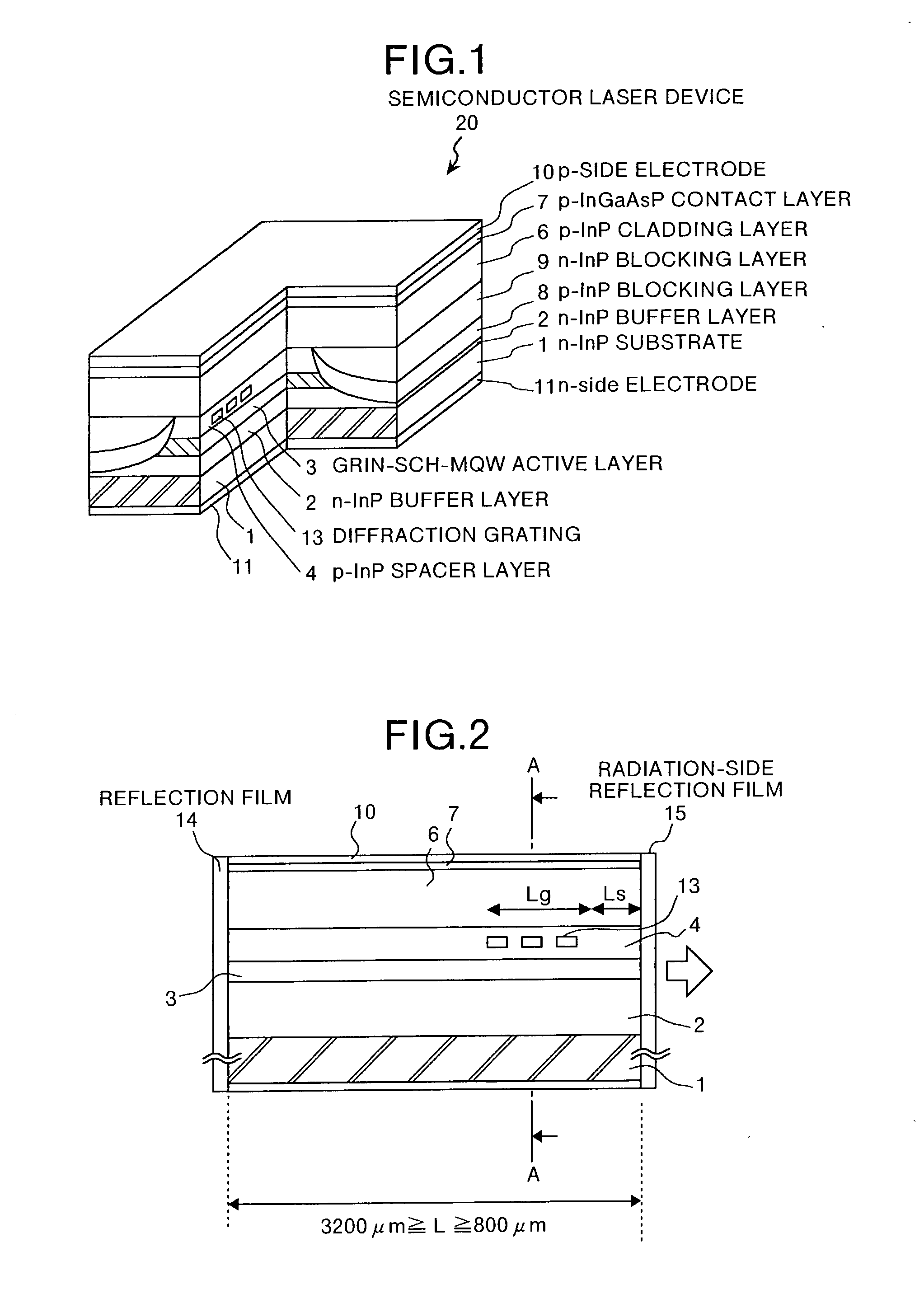Semiconductor laser device, semiconductor laser module, and raman amplifier using the device or module
a laser device and semiconductor technology, applied in the direction of lasers, lasers, optical resonator shapes and constructions, etc., can solve the problems of inability to carry out stable raman amplification, limited application excitation methods, and increase in costs, and achieve stable output and high efficiency
- Summary
- Abstract
- Description
- Claims
- Application Information
AI Technical Summary
Benefits of technology
Problems solved by technology
Method used
Image
Examples
first embodiment
(First Embodiment)
First, a first embodiment of the present invention will be, explained. FIG. 1 is a cutaway view of a semiconductor laser device according to a first embodiment of the present invention as viewed from a slanting direction. FIG. 2 is a longitudinal sectional view in a longitudinal direction of the semiconductor laser device shown in FIG. 1. FIG. 3 is a cross-sectional view of the semiconductor laser device shown in FIG. 2 taken along the line A-A. In FIGS. 1 to 3, a semiconductor laser device 20 has a structure in which on a plane (100) of an n-InP substrate 1, the following elements are sequentially laminated; an n-InP cladding layer 2 serving as a buffer layer and a lower cladding layer by an n-InP, a GRIN-SCH-MQW (Graded Index-Separate Confinement Heterostructure Multi Quantum Well) active layer 3 having compressive strain, a P-InP spacer layer 4, a p-InP cladding layer 6 and an InGaAsP contact layer 7.
The P-InP spacer layer 4 is provided therein with a diffrac...
second embodiment
(Second Embodiment)
A second embodiment of the invention will now be explained. In the second embodiment, the semiconductor laser device shown in the above-described first embodiment is modularized.
FIG. 14 is a longitudinal sectional view that shows a structure of a semiconductor laser module of the second embodiment of the invention. In FIG. 14, a semiconductor laser module 50 includes a semiconductor laser device 51 corresponding to the semiconductor laser device shown in the above-described first to third embodiments. The semiconductor laser device 51 is of a junction-down structure in which a p-side electrode is connected to a heat sink 57a. A Peltier element 58 as a temperature control device is disposed on a bottom surface inside a package 59 formed of ceramic as a housing of the semiconductor laser module 50. A base 57 is disposed on the Peltier element 58, and the heat sink 57a is disposed on the base 57. Current (not shown) is supplied to the Peltier element 58, and coolin...
third embodiment
(Third Embodiment)
Next, a third embodiment of the present invention will be explained. In the third embodiment, the semiconductor laser module shown in the second embodiment is applied to the Raman amplifier.
FIG. 15 is a block diagram that shows a structure of a Raman amplifier of the third embodiment of the invention. The Raman amplifier is used for the WDM communication system. In FIG. 15, the Raman amplifier uses semiconductor laser modules 60a to 60d having the same structure as that of the semiconductor laser module shown in the second embodiment, and it is of a structure such that semiconductor laser modules 182a to 182d shown in FIG. 22 are replaced by the above-described semiconductor laser modules 60a to 60d.
Each of the semiconductor laser modules 60a and 60b outputs a laser beam having a plurality of oscillation longitudinal modes to the polarization beam combiner 61a through a polarization maintaining fiber 71. Each of the semiconductor laser modules 60c and 60d outpu...
PUM
 Login to View More
Login to View More Abstract
Description
Claims
Application Information
 Login to View More
Login to View More - R&D
- Intellectual Property
- Life Sciences
- Materials
- Tech Scout
- Unparalleled Data Quality
- Higher Quality Content
- 60% Fewer Hallucinations
Browse by: Latest US Patents, China's latest patents, Technical Efficacy Thesaurus, Application Domain, Technology Topic, Popular Technical Reports.
© 2025 PatSnap. All rights reserved.Legal|Privacy policy|Modern Slavery Act Transparency Statement|Sitemap|About US| Contact US: help@patsnap.com



